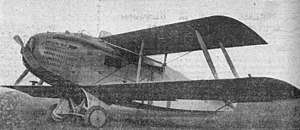Béchereau SRAP T.7
The Béchereau SRAP T.7 was a French single-engined seven-passenger sesquiplane airliner designed by Louis Béchereau who had designed biplane fighters for SPAD including the SPAD S.VII.[1] The aircraft was built by the Société pour la Réalisation d'Appareils.
| Béchereau SRAP T.7 | |
|---|---|
 | |
| Role | Sesquiplane airliner |
| National origin | France |
| Manufacturer | Société pour la Réalisation d'Appareils |
| Designer | Louis Béchereau |
| First flight | 1926 |
| Number built | 1 |
Design and development
The T.7 was an inverted Sesquiplane, the lower wing had a longer span than the upper.[1] Forward of the upper wing was an open cockpit for the pilot and mechanic, between the wings was an enclosed cabin for seven passengers.[1] It was powered by a 520 hp (388 kW) Salmson 18Cmb inline radial piston engine.[1] The aircraft failed to find any buyers and did not enter production.[1]
Specifications

Béchereau SRAP T.7 profile drawing L'Aéronautique December,1926
Data from [1]The Illustrated Encyclopedia of Aircraft
General characteristics
- Crew: 2 (pilot, mechanic)
- Capacity: 7 passengers
- Length: 10.70 m (35 ft 1¼ in)
- Wingspan: 16.90 m (55 ft 5¼ in)
- Height: 3.25 m (10 ft 8 in)
- Wing area: 60.0 m2 (645.86 ft2)
- Empty weight: 2370 kg (5225 lb)
- Gross weight: 4050 kg (8928 lb)
- Powerplant: 1 × Salmson 18Cmb 18 cylinder water-cooled in-line radial piston engine, 388 kW (520 hp)
Performance
- Maximum speed: 200 km/h (124 mph)
Armament
References
Notes
- Orbis 1985, p. 515
This article is issued from Wikipedia. The text is licensed under Creative Commons - Attribution - Sharealike. Additional terms may apply for the media files.